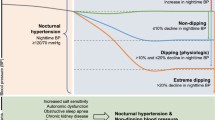Summary
This study determined the effect of pinacidil on the concentration of plasma lipids and apolipoproteins in male patients previously equilibrated with 25 mg hydrochlorothiazide twice daily.
Pinacidil therapy given to 52 hypertensives at 25 to 100 mg daily for 8 weeks resulted in a reduction of systolic and diastolic blood pressure concurrently to reductions in plasma cholesterol and triglycerides with no change in low density lipoprotein-cholesterol (LDL-C) and high density lipoprotein-cholesterol (HDL-C). There was an associated decrease in apolipoproteins (Apo)B, C-III and E and elevation in ApoA-I. A parallel placebo group of 44 patients experienced reduction in diastolic blood pressure and an elevation in ApoA-I.
These changes indicate that pinacidil will be a useful antihypertensive agent having properties on lipoprotein metabolism which would favor decreased risks of atherosclerosis.
Similar content being viewed by others
References
Arrigoni-Martelli E, Kaergaard Nielsen C, Bang Olsen U, Peterson HJ (1980) N''-cyano-N-4-pyridyl-N'-1,2,2 trimethyl-propylguanidine, monohydrate (P1134): A new, potent vasodilator. Experientia 36: 445–447
Byyny RL, Nies AS, LaVerde ME, Mitchell WD (1987) A double-blind, randomized, controlled trial comparing pinacidil to hydralazine in essential hypertension. Clin Pharmacol Ther 42: 50–57
Goldberg MR, Sushak MS, Rockhold FW, Thompson WL (1988) Vasodilator monotherapy in the treatment of hypertension: Comparative efficacy and safety of pinacidil, a potassium channel opener, and prazosin. Clin Pharmacol Ther 44: 78–92
Goldberg MR, Rockhold FW, Offen WW, Dornseif BE (1989) Dose-effect and concentration-effect relationships of pinacidil and hydrochlorothiazide in hypertension. Clin Pharmacol Ther 46: 208–218
Goldberg MR, Rockhold FW, Thompson WL, DeSante KA (1989) Clinical pharmacokinetics of pinacidil, a potassium channel opener, in hypertension. J Clin Pharmacol 29: 33–40
Southerton JS, Weston AH, Bray KM, Newgreen DT, Taylor SG (1988) The potassium channel opening action of pinacidil; studies using biochemical, ion flux and microelectrode techniques. Naunyn Schmiedebergs Arch Pharmacol 338: 310–318
Quasthoff S, Spuler A, Lehmann-Horn F, Grafe P (1989) Cromakalim, pinacidil and RP 49356 activate a tolbutamide-sensitive K + conductance in human skeletal muscle fibres. Pflugers Arch 414: S179-S180
Arena JP, Kass RS (1989) Enhancement of potassium-sensitive current in heart cells by pinacidil. Evidence for modulation of the ATP-sensitive potassium channel. Circ Res 65: 436–445
Woodcock BG, Reitbrock N (1984) Beta-blocker induced charges in the cholesterol: high-density lipoprotein cholesterol ratio and risk of coronary heart disease. Klin Wochenschr 62: 843–849
Weinberger MH (1986) Antihypertensive therapy and lipids. Paradoxical influences on cardiovascular risk. Am J Med 80: S64-S70
Rockhold FW, Goldberg MR, Thompson WL et al. (1989) Beneficial effects of pinacidil on blood lipids: Comparisons with prazosin and placebo in patients with hypertension. J Lab Clin Med 114: 646–654
Bucolo G, David H (1973) Quantitative determination of serum triglycerides by the use of enzymes. Clin Chem 19: 476–482
Allain CC, Poon LS, Chan CSG, Richmond W, Fu PC (1974) Enzymatic determination of total serum cholesterol. Clin Chem 20: 470–475
Manual of Laboratory Operations, Lipid Research Clinics Program. Lipid and Lipoprotein Analysis. DHEW Pub. No. (NIH) 75–628, pp. 71–74, 1974
Friedewald WT, Levy RI, Fredrickson DS (1972) Estimation of the concentration of low-density lipoprotein cholesterol, without use of the preparative ultracentrifuge. Clin Chem 18: 499–502
Curry MD, Alaupovic P, Suenram CA (1976) Determination of apolipoprotein A and its constitutive A-I and A-II polypeptides by separate electroimmunoassays. Clin Chem 22: 315–322
Curry MD, Gustafson A, Alaupovic P, McConathy WJ (1978) Electroimmunoassay, radioimmunoassay, and radial immunodiffusion assay evaluated for quantification of human apolipoprotein B. Clin Chem 24: 280–286
Curry MD, McConathy WJ, Fesmire JD, Alaupovic P (1980) Quantitative determination of human apolipoprotein C-III by electroimmunoassay. Biochim Biophys Acta 617: 503–513
Curry MD, McConathy WJ, Alaupovic P, Ledford JH, Popovic M (1976) Determination of human apolipoprotein E by electroimmunoassay. Biochim Biophys Acta 439: 413–425
Cham BE, Knowles BR (1976) A solvent system for delipidization of plasma or serum without protein precipitation. J Lipid Res 17: 176–181
SAS Institute (1985) SAS Users Guide: Basics, 5th ed. Cary, NC: SAS Institute
Johnson BF (1982) The emerging problem of plasma lipid changes during antihypertensive therapy. J Cardiovasc Pharmacol 4: S213-S221
Cutler R (1982) Effect of antihypertensive agents on lipid metabolism. Am J Cardiol 51: 628–631
Corder CN, Goldberg MR, Alaupovic P, Price MD (1988) Apolipoprotein levels in hypertensive patients receiving hydrochlorothiazide. Atherosclerosis 8: 589a-590b
Alaupovic P, McConathy WJ, Fesmire J, Tavella M, Bard JM (1988) Profiles of apolipoproteins and apolipoprotein B-containing lipoprotein particles in dyslipoproteinemias. Clin Chem 33: B13-B27
Grundy SM, Vega GL (1990) Role of apolipoprotein levels in clinical practice. Arch Intern Med 150: 1579–1582
Wang CS, McConathy WJ, Kloer HU, Alaupovic P (1985) Modulation of lipoprotein lipase activity by apolipoproteins. Effect of apolipoprotein C-III. J Clin Invest 75: 384–390
Blankenhorn DH, Alaupovic P, Wickham MS, Chin HP, Azen SP (1990) Prediction of angiographic change in native human coronary arteries and aortocoronary bypass grafts. Lipid and nonlipid factors. Circulation 81: 470–476
Keys A, Menott A, Aravanis C, Blackburn H, Djordevic BS, Buzina R, Dontas AS, Fidanza F, Karvonen MJ, Kimura N, Mohacek I, Nedeljkovic S, Puddu V, Punsar S, Taylor HL, Conti S, Kromhout D, Toshima H (1984) The Seven Countries Study: 2,289 Deaths in 15 years. Prev Med 13: 141–154
Bachorik PS, Kwiterovich PO (1988) Apoliprotein measurements in clinical biochemistry and their utility vis-a-vis conventional assays. Clin Chim Acta 178: 1–34
Corder CN, Goldberg MR, Alaupovic PA, Price MD (1989) Lipoprotein changes during therapy with pinacidil. Clin Pharmacol Ther 45: 184
Author information
Authors and Affiliations
Rights and permissions
About this article
Cite this article
Corder, C.N., Goldberg, M.R., Alaupovic, P.A. et al. Lipid and apolipoprotein levels during therapy with pinacidil combined with hydrochlorothiazide. Eur J Clin Pharmacol 42, 65–70 (1992). https://doi.org/10.1007/BF00314922
Received:
Accepted:
Issue Date:
DOI: https://doi.org/10.1007/BF00314922




